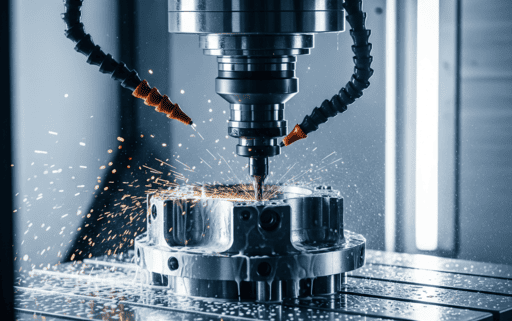Many industries struggle to achieve precision for complex parts. Traditional methods limit efficiency and surface quality. 4-axis CNC machining solves these problems by producing accurate parts faster.
Four axis cnc is a type of computer-controlled manufacturing where the machine tool can move in X, Y, and Z axes, plus rotate around an additional axis. This allows the cutting tool to reach multiple sides of the workpiece in a single setup, reducing manual repositioning and increasing efficiency.
Now, let us explore how it works, its benefits, and where it is used.
What is 4-axis CNC machining?
4-axis cnc machining involves adding a rotating axis, often called the A-axis, to the three traditional cnc axes. This additional movement enables the machining of angled features, holes, or complex curves without removing the workpiece. Compared to three-axis systems, it allows for more complex geometry and improved accuracy. It is often applied in aerospace, automotive, medical, and electronics manufacturing for parts that demand multiple faces to be machined with minimal repositioning.

How does 4-axis CNC Machining Work?
In 4-axis CNC machining, the workpiece is fixed on a table that can rotate around the A-axis. While the cutting tool moves back and forth in the X, Y, and Z directions, the table’s rotation lets the tool reach areas that would be hard or impossible to cut with only three axes. This rotation is especially useful for making parts with angled features, curved surfaces, or deep cavities.
Comparison of CNC axis capabilities
| Axis Type | Movements | Suitable Applications | Complexity Level |
|---|---|---|---|
| 3-Axis | X, Y, Z | Simple shapes, flat surfaces, drilling straight holes | Low |
| 4-Axis | X, Y, Z + A-axis rotation | Parts with multiple sides, angled holes, curved profiles | Medium |
| 5-Axis | X, Y, Z + two rotating axes (A, B, or C) | Extremely complex shapes, aerospace components, medical implants |
Advantages and Disadvantages of 4-Axis CNC Machining
4-axis CNC machining offers clear benefits in terms of speed, precision, and versatility, but it also comes with certain trade-offs such as higher costs and more complex operation. Understanding both sides helps in deciding whether it’s the right choice for your production needs.
| Aspect | Advantages | Disadvantages |
|---|---|---|
| Efficiency | Can machine multiple faces in one setup, reducing cycle times. | For simple parts, the extra axis may offer little benefit. |
| Accuracy | Fewer setups mean less risk of alignment errors and dimensional variation. | Requires precise calibration and skilled programming to maintain accuracy. |
| Surface Finish | More consistent finishes, especially on curved or sculpted surfaces. | Incorrect programming can lead to visible tool marks on complex contours. |
| Labor & Production | Reduces manual handling, lowers labor costs for medium/high-volume runs. | Operators need advanced training, which adds to labor costs initially. |
| Cost | — | Higher purchase price, maintenance costs, and software investment compared to 3-axis machines. |
4-Axis CNC Machining Applications in Various Industries
4-axis CNC machining is highly versatile and widely used across multiple industries because it can handle complex shapes, multiple faces, and high-precision requirements.
-
Aerospace
It’s commonly used to manufacture turbine blades, brackets, and other parts with intricate curves. The added rotation axis allows precise machining of complex contours that would be difficult on a standard 3-axis machine.
-
Automotive
Engine blocks, gear housings, and other automotive components often require work on several faces. 4-axis CNC lets manufacturers complete these parts in a single setup, saving time and reducing alignment errors.
-
Medical
Surgical instruments and orthopedic implants need smooth surfaces and very tight tolerances. 4-axis machining ensures accuracy and consistency, which is critical in medical applications.

-
Electronics
Complex housings, heatsinks, and enclosures can be produced more quickly and accurately with the extra axis, improving both efficiency and product quality.
-
Mold Making
Injection molds, dies, and other detailed cavities require precision that 4-axis CNC provides. It enables the creation of intricate shapes with minimal manual repositioning.
4-Axis CNC vs 3-Axis and 5-Axis Machining
4-axis CNC machining sits between 3-axis and 5-axis systems in terms of complexity and capability. Compared to 3-axis machines, it offers more flexibility because the extra rotating axis allows machining of angled surfaces, holes, and complex curves without constantly repositioning the workpiece. This saves time and reduces the chance of errors.
Compared to 5-axis machines, 4-axis CNC is more cost-effective for parts that don’t need the full range of motion. While 5-axis machines can handle extremely complex geometries, they are more expensive and harder to program. For many applications, 4-axis machining provides the best balance between precision, versatility, and investment, it ideal for medium-complexity parts in industries like automotive, medical, and electronics. At VMT, we also provide advanced 5-axis machining services, enabling the production of highly complex components with superior precision and reduced setups. We can machine intricate geometries, undercuts, and multi-surface parts in a single operation, improving efficiency and accuracy. Contact us today for a free quote.

Start your CNC machining project at VMT
VMT boasts 100 advanced machine tools, including four-axis milling and four-axis CNC equipment, enabling rapid part delivery within 24 hours. Our team boasts precision control up to 0.005mm and surface finishes that meet consumer electronics standards, supporting industries ranging from automotive to medical. Contact us today for a free quote.
Frequently Asked Questions About 4- axis CNC Machining
What is the difference between 4 and 5 axis CNC?
A 4-axis CNC adds a single rotary axis (A or B) to the standard X, Y, Z linear axes, allowing the workpiece to rotate for angled cuts. It’s suitable for cylindrical parts or features on multiple sides. A 5-axis CNC adds two rotary axes, enabling the tool to approach the workpiece from almost any direction. This allows complex 3D surfaces to be machined in a single setup, reducing manual repositioning and improving precision for aerospace, automotive, and mold applications.
What is the difference between 3 axis CNC and 4 axis CNC?
A 3-axis CNC moves the cutting tool along X, Y, and Z, suitable for flat surfaces and simple 3D shapes. A 4-axis CNC adds a rotary axis, allowing the workpiece to rotate around one axis (typically A-axis). This enables machining on multiple sides without repositioning, improves efficiency for cylindrical or prismatic parts, and allows more complex geometries like helical cuts or grooves, which 3-axis machines cannot handle efficiently.
What is XYZ axis CNC?
XYZ-axis CNC refers to a standard 3-axis machine with linear movements: X = left/right, Y = forward/back, Z = up/down. This is the most common CNC setup and is used for milling, drilling, and cutting flat or simple 3D parts. It cannot rotate the tool or workpiece, so it requires multiple setups for angled or complex surfaces. Most entry-level CNC machines, including desktop mills and routers, operate in XYZ axes only.
What is a 6-axis CNC?
A 6-axis CNC combines three linear axes (X, Y, Z) with three rotary axes (A, B, C), allowing the tool to move and rotate in almost any orientation. This enables complex, freeform 3D surfaces and undercuts in a single setup. It is used for highly precise and complex parts, including aerospace components, automotive molds, and medical implants. The extra axes reduce setup time, improve accuracy, and allow simultaneous multi-axis machining of intricate geometries that 3-, 4-, or 5-axis machines cannot achieve efficiently.




